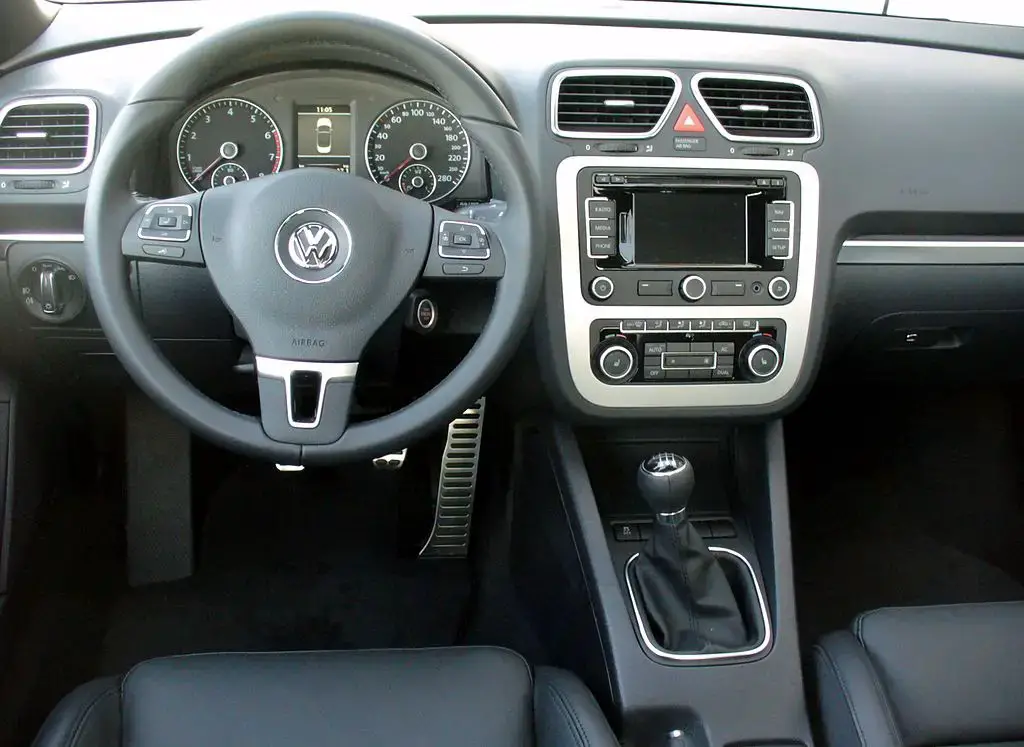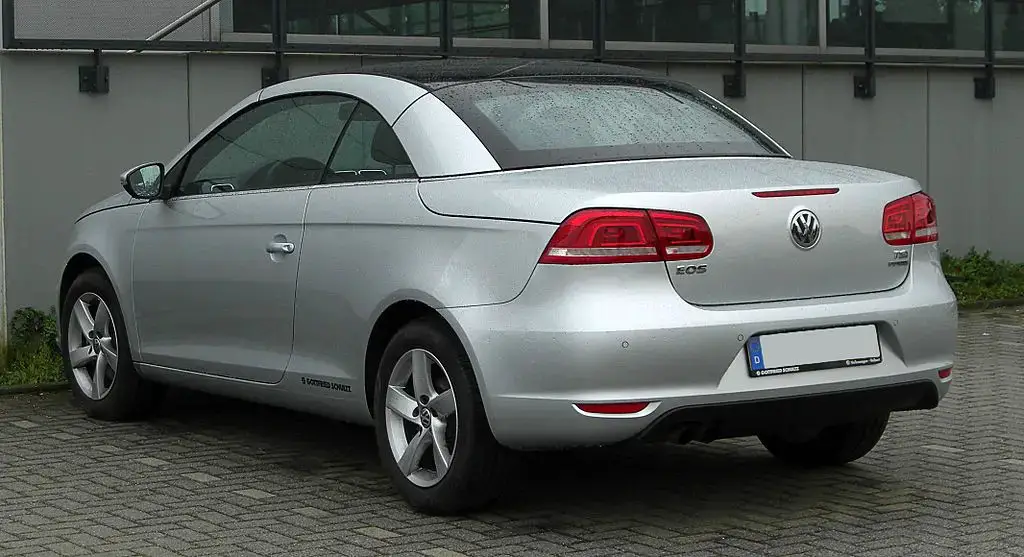Review: VW EOS ( 2006 – 2015 )

VW EOS. Because you deserve it. And maybe because a Golf convertible just seems like a lazy attempt to grab some more cash. Either way, the VW EOS enters the Almost Cars ring because it’s still a relevant car on the used market.
You could say it’s one of the most popular convertibles on the used market. In fact, if I sit and scratch my bottom and think about how many convertibles we have on the market, I discover that the options are fewer than what life offers you when you graduated from geography college. You’ve got the Ford StreetKa that nobody’s buying. You’ve got the Peugeot 206 and 307cc that were popular at the same time as Andre the Giant was making summer videos. There was the Renault Megane and Ford Focus, which nobody bought, so the market was essentially left with the BMW E46 and Opel Astra H convertibles, cars that wore out faster than even the summer band dancers.
So that left standing the VW EOS which is effectively the Golf of convertibles. Literally. Because it’s actually built on the Golf V platform, only it’s not a Golf V convertible but a proper convertible. You have two seats in the front and two attempts of rear seats, but mainly you have a metal roof and you have a real convertible look, like a Mercedes SLK or Volvo C70. And that meant that the VW EOS was an affordable, reliable convertible with parts you could actually find everywhere. They just had to add the old 1.9 TDI and we didn’t need to buy anything else. That’s because the VW EOS is a dubious bad car in terms of reliability, being built for 10 years without having very big differences, getting the complementary Golf VI facelift but overall there are not very big differences between a 2006 EOS and 2015 one, that is if you can find 2015 ones because by 2012 it was already packing up because it seems convertibles were not finding their place in this world anymore.

VW EOS Engines
Petrol
- 1.4 Turbo of 122 and 158 horsepower – You’d expect this engine to be the most popular on the EOS, and you’d be wrong. Essentially we have the 122 horsepower version with a single turbo, and the 158 horsepower twincharger is also supercharged, so there’s something extra to break down. And it’s actually the 1.4 TwinCharger is probably VW’s worst engine in the recent period, reliability-wise.
- 1.6 FSI of 116 horsepower – Only available between 2007 and 2008. Good luck. It pops up occasionally in ads, but not enough. Probably because people didn’t really want the softest engine.
- 2.0 FSI of 150 horsepower – So they chose to work harder and bought a 150 horsepower 2.0 FSI, which is a surprisingly popular engine. Like the 1.6 FSI, it needs quality petrol, has more electrical issues than an MPI and the timing is more expensive to replace. But overall it’s a great engine even if you want to use the EOS on a daily basis. You have to be careful with the manual gearbox though because the 2nd gear synchro has a tendency to malfunction.
- 2.0 Turbo of 200-horsepower – Ah, the classic 2.0 TFSI. Torpedo of an engine where you can’t figure out which consumes more – petrol or oil. Sure, it has the other TSI issue, but the 2.0 TFSI’s (and 1.8 TFSI’s but not available here) particularity is oil consumption. But at least it gets the mileage, fast.
- 3.2 Vr6 250 horsepower – Apparently somewhere in a garage there’s the 3.2 Vr6 250 horsepower engine, which is basically decently reliable, except it’s more of a Phaeton and Touareg engine than an EOS companion. Not to say that it’s not, but the engine puts a lot of pressure on the nose of the car and that creates issues with both the life of the suspension, engine mounts, tyres and everything else, as well as affecting the dynamics of the car. Specifically, it understeers.
Diesel
2.0 TDI of 140 horsepower – We were supposed to get a complementary diesel, so the Germans at VW didn’t bother too much and put the standard 2.0 TDI in the Golf V, which is a decent diesel. It just suffers from the classic 2.0 TDI issues of the dual mass flywheel wearing out prematurely and in extreme cases taking the gearbox with it. Then you have the particle filter that clogs up quickly, and the general idea is that if you only drive it around town, you’re in for it.

VW EOS General Issues
- General issues with all the plugs and seals on the car and that translates to it raining in your car, everywhere.
- TSI petrol engines up to 2013-2014 have timing chain and are notorious for timing chain stretcher issues. So check your TSI engine to see what kind of timing it has, because somewhere in 2013 or 2014 they switched to belt timing.
- The DSG type automatic transmission is the classic automatic transmission in the VW range and that translates to changing the oil and filter every 60,000 miles but also lighting a candle and saying a prayer in the hope that the Mechatronic unit doesn’t break down.
- The G201 sensor for ESP has been a recurring issue on most European cars since 2005 that bought ABS sensors from Valeo, only to have customers say “screw it”.
- Unlike the Golf Cabriolet, the EOS has a metal roof and that means you have to check if the drive is working properly because in most cases it doesn’t work.

VW EOS Verdict
To recap. The VW Golf Cabrio has a cheap fabric roof and seats 4 people. The VW EOS has a metal roof and 2 seats in the front for people and 2 seats in the back for pets or purses. So it’s a more expensive and better-looking VW. And probably the most popular real convertible in our country with a metal roof. Is it worth it instead? If you want a real convertible but don’t want to break your bank account, then sure. But it’s only an entry-level convertible.
What engines do I recommend? For petrol 2.0 TFSI after 2013 (with belt drive) or 1.6 FSI 115 hp, and for diesel anyway you have only the 2.0 TDI 140 hp.
Similar Articles

Review : Toyota Verso AR20 ( 2009 – 2013 )

Review : Skoda CitiGO ( 2011 - 2020 )

Review : Seat Mii ( 2011 - 2020 )
Write an answer
-
-
Briansclub
You’ve successfully demonstrated your ability to work as a team. I’m forward to collaborate with you on additional projects. briansclub cm
- Review : Toyota Verso AR20 ( 2009 – 2013 ) 10 November 2025
- Review : Skoda CitiGO ( 2011 - 2020 ) 02 August 2025
- Review : Seat Mii ( 2011 - 2020 ) 02 August 2025
- December 2025
- November 2025
- October 2025
- August 2025
- July 2025
- April 2025
- March 2025
- February 2025
- January 2025
- December 2024
- November 2024
- October 2024
- August 2024
- July 2024
- June 2024
- May 2024
- April 2024
- March 2024
- February 2024
- January 2024
- December 2023
- November 2023
- October 2023
- September 2023
- August 2023
- July 2023
- June 2023
- May 2023
- April 2023
- March 2023
- February 2023
- January 2023
- December 2022
- November 2022
- October 2022
- September 2022
- August 2022
- July 2022
- June 2022
- May 2022
- March 2022
- April 2021
- January 2021
- December 2020
- November 2020
- October 2020
- September 2020
- August 2020
- July 2020
- March 2020
You’ve successfully demonstrated your ability to work as a team. I’m forward to collaborate with you on additional projects. briansclub cm